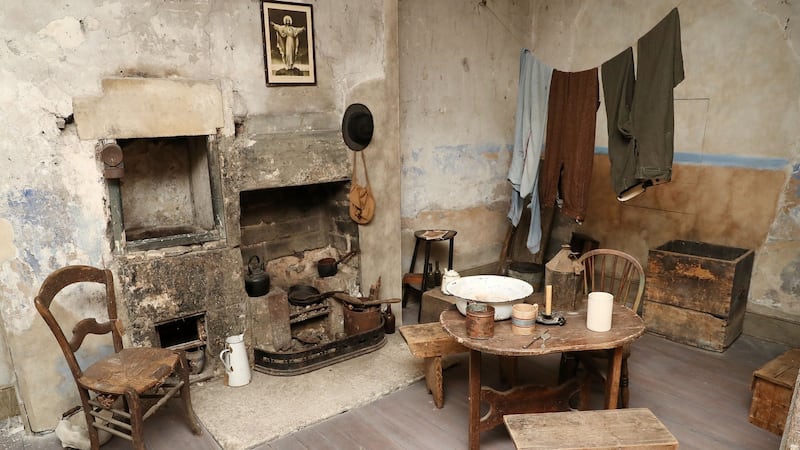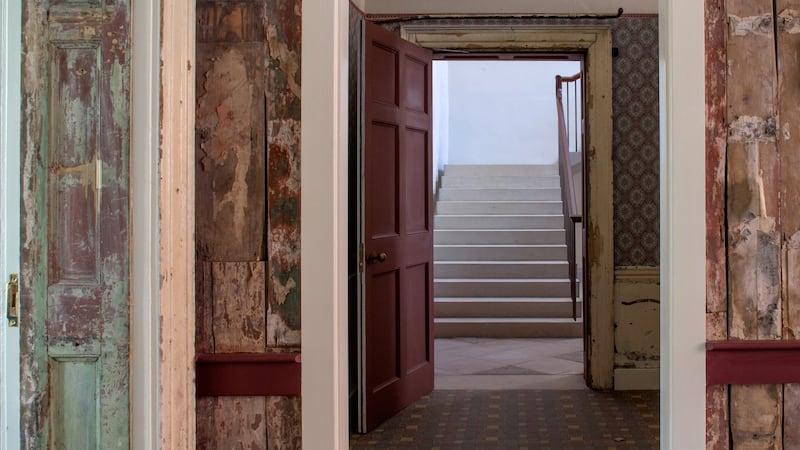If these walls could talk . . . Well actually, if you put the gentle squeeze on them, they do.
Just inside the large front door of 14 Henrietta Street is a picture of the Holy Family on the wall. It hangs from the same nail that was stuck there when the Brannigan family – 11 children and their parents – lived in the small room, part of the once-grand entrance hall, in a section partitioned off from the doorway.
The picture is laden with significance: it represents the family’s life in the tenement house, and indeed that of many families living in Dublin tenements from the late 19th century on.
Peter Brannigan and I are standing in the room – the hall – looking at where his childhood bed stood, at the foot of a now re-instated staircase. He shared it with several brothers (the family of 13 slept in two beds). He points out where the furniture was: a dresser, sideboard, chest of drawers, small table in the window with the Sacred Heart. It’s hard to to see how it all fit.
His father, who worked for the army, could cure anything with iodine, and his mother was a wonderful cook, he says. The family often relied on the kindness of the Sisters of Charity across the road for food – stew in an enamel jug, perhaps. For his First Communion he borrowed clothes and shoes. There was no electricity or running water, and two toilets were shared by 100 residents. “You’d bang on the wall on the way, to scare the rats away.”
Down in the basement tenement of number 14, Brannigan looks at a small cast-iron bed in a corner by a window. “I was born right there in 1939. They joked that the neighbours saw me being born before my father did.” He was lucky, he says, to be born in summer, because child mortality was high.
His family lived in the damp, cold room before moving upstairs to the warmer, drier flat in the hall. They moved out to a Donnycarney council house in 1949.
Misery vs community
If it all sounds a bit miserable, and a lot deprived, the other thing that comes across is the fabled closeness and support of the community, the colour of people shouting to each other – Cooneys, Hannigans, Connollys, Mooneys and others, he names – up and down the busy back stairs, hundreds of children playing on the street outside, and the happiness and love of his family.

The careful exposition of the lives of this house opens to the public this weekend, offering a layered slice of Dublin social history, after years of work and engagement by historians, local people, conservation architects, former residents such as Peter Brannigan and Dublin City Council (DCC), which owns it.
The Georgian terraces on the north Dublin street were laid out by Luke Gardiner in the 1720s. Number 14 was built in 1748, and the first residents were Richard Molesworth (a lord viscount) and Mary Jenney Usher, who had two children there. The fashionable street was home to peers, landed and merchant families, and later was a legal district. In 1850, number 14 became HQ for the Encumbered Estates Court – the Nama of its day.
In 1877, number 14 was bought by landlord Thomas Vance, who removed the stairs to create two extra rooms, and subdivided the grand rooms by part-height partitions, creating 19 flats of up to four "rooms" each. The house's life as a tenement had begun, and was to last over 100 years.
By 1901, there were 17 families – 87 people – living in number 14; the 1911 census shows 100 residents in multigenerational families. There were 1,000 on the street. In 1979, the last families left, for new homes in the suburbs, and new challenges. The house fell into disrepair and, after years of court-wrangling, was compulsorily purchased by city council.
These days they're coming back, says Iseult Byrne, chief executive of the council's Culture Company, manager of the museum. They've had "reminiscence days" collecting oral history, and locals and former residents have toured the house.
Last weekend, tour guide Tracey Bardon, herself born in a tenement, led our group. A grand room upstairs, with legal symbols on the cornicing and painted in period colours, houses a model of the house, showing the sub-divided rooms.
Fragments of lives
Mrs Dowling's flat, from the 1960s, has been carefully reconstructed, and shows how the fragments of lives lived in the house have been pieced together, by the Dowlings, city heritage officer Charles Duggan, project curator Dr Ellen Rowley and conservation architect Grainne Shaffrey. (This year the project was Best Conservation/Restoration Project, and won the Special RIAI Jury Award.)
There was no bathroom or running water, but this is a small comfortable home, with a piano where mother and daughter gave lessons.

The Dowlings’ own overmantle, china and china cabinet are back in place, along with a precious doll. The bedroom has a bed and a sewing machine; another bed is in the corner of the living room. Shaffrey talks about how they pieced together lino and wallpaper fragments and recreated it.
In hallways, the characteristic tenement paint remains: Raddle Red below the rail – “it was dark and forgiving” – and above, Reckitts Blue, which was thought to have hygienic qualities, masking the smell of mass habitation.
Scrawled on to a wall in a hallway is a warning from an unknown (apparently busybody) resident, at some stage in the house’s life: “ANN PERSION WHO TAMPERS WITH ANNY TING OR WHO IS NOT READINT IN THIS HOUSE WILL BE PROSACUHTEAD BY LAW”.
They were not trying to fill in the gaps or make it look as it did, says Shaffrey. The conservation aim is “to communicate authenticity and reality, as opposed to, say, a stage set, which aims to communicate ideas or an image”.
The basement flats were grim, Shaffrey observes, but “the Henrietta Street flats were regarded as slightly tonier than other tenement streets”.
What they call "Darkest Dublin" is in the basement, almost pungent with poverty, inspired by photographs of 1913 living conditions by John Cooke. In this tenement, a clothes line stretches across the corner; the single wooden chair is low – probably because part of the legs were cut off for firewood.
14henriettastreet.ie
















